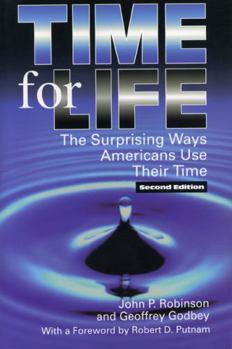Time for Life
Select Format
Select Condition 
Book Overview
Is it possible that Americans have more free time than they did thirty years ago? While few may believe it, research based on careful records of how we actually spend our time shows that we average more than an hour more free time per day than in the 1960s. Time-use experts John P. Robinson and Geoffrey Godbey received national attention when their controversial findings were first published in 1997. Now the book is updated, with a new chapter that includes results of the 1995 1997 data from the Americans' Use of Time Project. Time for Life, an outstanding work of scholarship that manages to be highly readable, demands the attention of everyone interested in what s happening in today s society. Edward Cornish, The Futurist Time for Life . . . is excellent fodder for lively classroom discussions, not only about family time use, but about the ontological and epistemological assumptions in the prevailing post-positivist paradigm of family science. Alan J. Hawkins and Jeffrey Hill, Journal of Marriage and the Family Regardless of where you stand on this issue, Robinson and Godbey's arguments and data make for very interesting reading and open a cultural window on American society. . . . This is a piece of scholarship that should be read and its conclusions contemplated by people well outside the readership of this journal. . . . Time for Life is good social science research that should appeal to a broad audience. Journal of Communication"
Format:Hardcover
Language:English
ISBN:0271016523
ISBN13:9780271016528
Release Date:April 1997
Publisher:Penn State University Press
Length:392 Pages
Weight:1.60 lbs.
Dimensions:1.3" x 6.3" x 9.3"
Customer Reviews
2 ratings
A study of what folks really spend their time on
Published by Thriftbooks.com User , 17 years ago
And it's not a pretty picture overall, but we didn't expect it to be, did we? We all seem to feel the pressures of not enough time, of "to-do" lists that never shrink, and of work-time creeping into our personal-time. The book is best when laying out the data and the results of the time-diary studies measuring what folks really do spend their time on, as they spend it, rather than in retrospect. Some of the conclusions are not obvious, and are that much more interesting for it. The solutions presented though are simplistic and often slip into pop psychology babble, in my opinion. But that isn't the point of the book, the "how we spend time" is. Moving on from there is for each of us individually and (probably) some other book. Oh yeah, and remove the TV from your house. You don't need it. And you won't miss it as much as you think.
Slowing down life's pace is necessary: here's how and why!
Published by Thriftbooks.com User , 26 years ago
I have been preparing lectures on stress management and came upon the work of the authors' Use of Time Project which has tracked Americans expenditures of time over decades. This book has caused me to re-think all of my assumptions, and fits in beautifully with some of the brand new books coming out in the wellness field, including Dean Ornish's Love and Survival: The Scientific Basis for the Healing Power of Intimacy and Paul Pearsall's The Pleasure Prescription: To Love, To Work and To Play. Time for Life shows, in methodical yet eloquent thoroughness, that the sense of hurry sickness and time famine is illusory and unnecessary: we in fact have ENOUGH time and money to be happy, yet we think we do not. The final chapter is worth the price of the book: called Brother, can you spare some time? it points out that the pace of life is a political issue, and that the commercialization of leisure can be critiqued and questioned, that while most of us lead lives of unbelievable privilege, happiness eludes us. This does not have to be the case. This is a scholarly book, yet accessible to the lay reader, particularly if you skip around some. The cross cultural stuff is fascinating (eg., Japanese people work longer hours yet don't feel the time famine like Americans do.) It is well worth the careful reading this important topic warrants. I am indebted to Mr. Robinson and Godbey for this expression of their life's work. I am deeply grateful, in fact.





